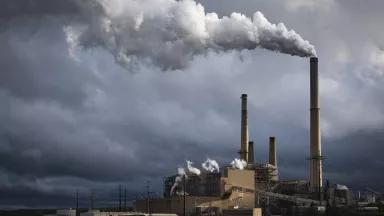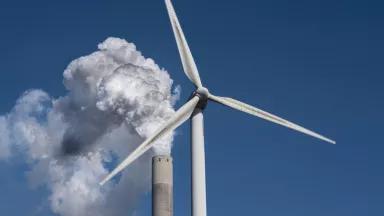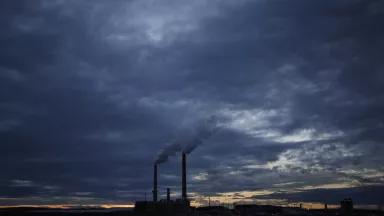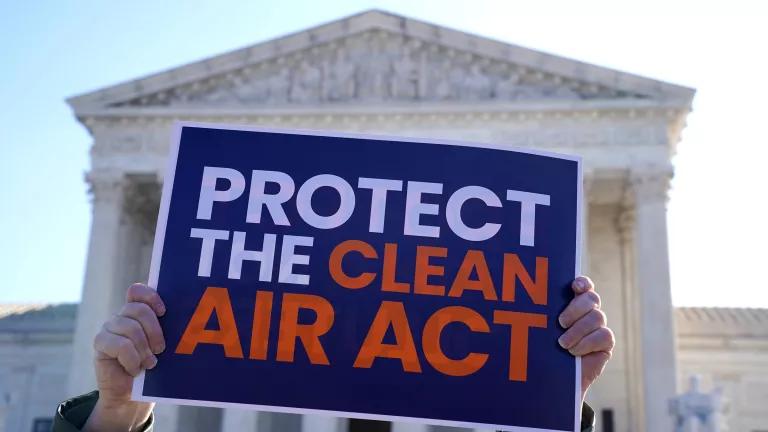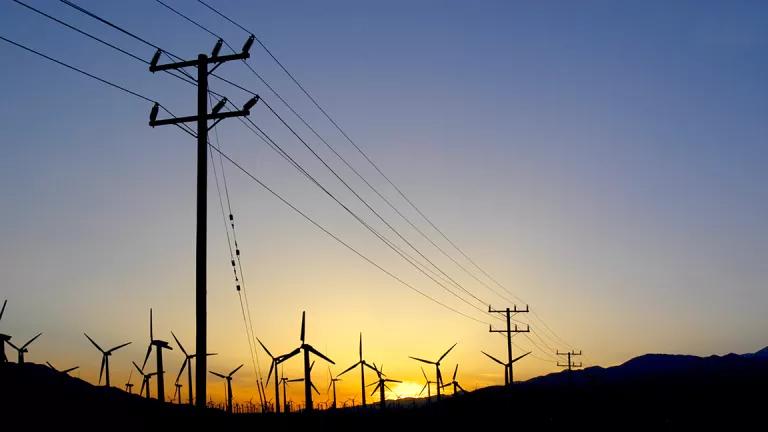The EPA Tackles Power Plants’ Carbon Pollution
The agency’s proposal to limit carbon pollution from coal- and gas-fired power plants—which until now has gone nearly unchecked—is a vital step toward combating climate change.

The gas-fired Lake Side Power Station in Utah
Mscalora via Wikimedia Commons, CC BY-SA 4.0
The U.S. Environmental Protection Agency (EPA) today announced a long-awaited proposal to limit carbon pollution from power plants under the authority of Clean Air Act Section 111. The new proposal would require carbon pollution reductions from the coal- and gas-fired power plants responsible for almost one-third of the United States’ carbon footprint—which until now has gone nearly unchecked.
The proposed standards rest on a strong legal foundation. Last year’s U.S. Supreme Court decision in West Virginia v. EPA clarified that the agency must base the “best system of emission reduction” (BSER) on pollution controls or measures that can be applied onsite at power plants. Then, the landmark Inflation Reduction Act reaffirmed the EPA’s authority over greenhouse gases and directed the agency to proceed with setting new standards under the existing law, in addition to providing enormous incentives for clean energy and pollution-reduction technology.
The EPA’s new proposal establishes emission limits, based on pollution control technology or lower-carbon fuels, for:
- new gas plants;
- the largest existing gas plants that run most often (while requesting comment on the rest of the existing gas fleet); and
- existing coal plants (new coal plants are already covered by standards).
Power companies and states have multiple options to meet the proposed standards: They can install the BSER technology, opt to run a plant less often and comply with a less-demanding standard, or retire the plant and replace it with new clean energy.
1. New gas plants
The proposal divides new gas units into subcategories based on how often the unit will operate (i.e., the unit’s capacity factor or CF). For the subcategory of units that will operate most often, the EPA sets a standard based on 90 percent carbon capture and storage (CCS), with an alternative pathway for complying with an equivalent standard by co-firing with clean hydrogen (H2). Less stringent standards are set for units that will operate less frequently. The standards phase in over time, with day-1 emission limits based on the most efficient turbines and full compliance required by 2035 if deploying CCS, or 2038 if co-firing hydrogen.
Subcategory | Emission Limit Basis (BSER) & Standard | |
Phase 1 | Phase 2 | |
Base Load (>~50% CF) | Efficient combined cycle turbine (770 lb CO2/MWh) | 90% CCS by 2035 (90 lb CO2/MWh) or 30% clean H2 by 2032 (680 lb CO2/MWh) & 96% by 2038 (90 lb CO2/MWh) |
Intermediate (20 to ~50% CF) | Efficient simple-cycle turbine (1,150 lb CO2/MWh) | 30% clean H2 by 2032 (1,000 lb CO2/MWh) |
Low Load (<20% CF) | Use of lower-emitting fuels (120–160 lb CO2/MMBtu) | |
The EPA proposes to define “clean” hydrogen based on the criteria to qualify for the highest tier of the Inflation Reduction Act section 45V clean hydrogen tax credit (i.e., up to 0.45 kg CO2e/kg H2), and requests comment on whether and how the agency should account for the lifecycle emissions of hydrogen production. The EPA also takes comment on the proposed percentages of hydrogen co-firing and CO2 capture, whether to retain the alternative pathway for a hydrogen co-firing BSER for the base load subcategory, and whether the compliance dates should begin earlier.
2. Existing gas plants
The EPA proposes emission limits for the largest and most frequently used existing gas units—those that are 300 megawatts (MW) or larger that run at 50 percent capacity factor or higher. The limits for the covered group of existing gas plants mirror the standards for new gas plants.
Plant Size & Capacity Factor | Emission Limit Basis (BSER) |
>300 MW & >50% CF | 90% CCS by 2035 or 30% clean H2 by 2032; 96% by 2038 |
<300 MW &/or <50% CF | No proposal—comments requested |
The EPA requests comment on the capacity factor and capacity thresholds for the covered group of existing gas units, and on approaches for the rest of the existing gas fleet.
3. Existing coal plants
The EPA acknowledges that many existing coal plants may retire over the coming years independent of the new standards, and that the cost-effectiveness of pollution controls will depend on a plant’s operating horizon. In light of those dynamics, the EPA is proposing an emission limit based on 90 percent CCS for coal-fired units that plan to continue operating past January 2040, with less stringent limits for units that commit to an enforceable retirement date earlier than 2040.
Retirement Date | Emission Limit Basis (BSER) |
2040 and beyond | 90% CCS starting 2030 |
Before 2040 | 40% co-firing with gas starting 2030 |
Before 2035 | Routine operation & maintenance; maintain historical emissions performance + 20% capacity factor limit starting 2030 |
Before 2032 | Routine operation & maintenance; maintain historical emissions performance |
The EPA requests comment on the proposed threshold dates and operating horizons, as well as whether to set an emission limit based on gas co-firing for plants retiring before 2035.
Compliance
The standards for new gas plants will apply to any new plant that commences construction after the proposed rule is published in the Federal Register.
Emission limits for existing coal and gas plants will be implemented through a state planning process. After the EPA issues a final rule, states will have two years to develop compliance plans and submit them to the EPA for approval. State regulators have considerable flexibility in how they apply EPA’s emission limits to existing sources in their state but will need to demonstrate that their plan is equivalent to the EPA’s guidelines. The proposed guidelines also require states to meaningfully engage with stakeholders—particularly those communities that are most affected by power plant emissions.
The EPA proposes a set of enforceable “increments of progress” that must be included in the state plan to ensure that existing plants that will use co-firing or CCS for compliance do the necessary planning, permitting, and construction in time to meet compliance deadlines. The EPA also proposes planning milestones for existing coal plants that opt to retire before 2040, to ensure that plant owners complete the necessary regulatory steps to enable permanent closure of the plant by the enforceable retirement date.
The proposal also acknowledges community concerns about the deployment of CCS, such as pipeline safety and geologic sequestration, and takes comment on the EPA’s assessment of the existing regulatory framework that governs CCS projects. The EPA commits to working with the other federal agencies that have responsibility for regulating CCS projects and with state and tribal governments to protect communities from pollution and ensure meaningful engagement.
Benefits
According to the EPA’s analysis, the proposals for existing coal plants and new gas plants would cut carbon emissions by 617 million metric tons through 2042 and the proposal for existing gas plants would reduce carbon pollution by 214 to 407 million metric tons through 2042—on top of the baseline emission reductions expected due to Inflation Reduction Act incentives and industry trends. The EPA also projects nationwide reductions in health-harming emissions of nitrogen oxides, sulfur dioxide, and fine particle pollution, and monetized total net climate and health benefits of up to $85 billion by 2042.
Opportunities for improvement
While this proposal is a vitally important first step, the EPA can do more, and faster. One clear opportunity for securing greater emissions reductions is setting limits for more existing gas plants by lowering the unit size and capacity factor thresholds. And the EPA can—and should—adjust the timelines for compliance across all three categories to require emissions reductions sooner.
The climate crisis is urgent—every ton of carbon pollution we reduce in the near term will help reduce the impacts we face and the suffering we must endure. The power industry has the tools it needs to cut its outsize contribution to our country’s carbon footprint. This proposal, with a few improvements, will ensure fossil power plants reduce their emissions commensurate with the best tools available.

